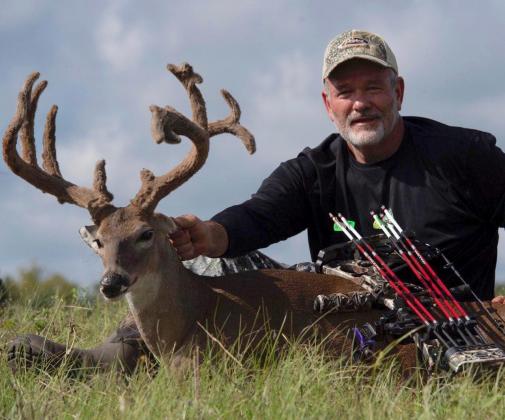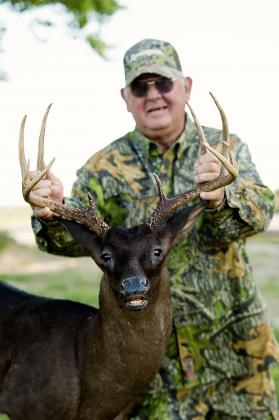Freaks of Nature
The weather was hot and muggy as the 2019 Texas Archery Only season for white-tailed deer got underway in late September, but the weekend turned out super cool for Chris Barrilleaux of Splendora.
Hunting on a private lease along the Trinity River in San Jacinto County, the 58-year-old grocery store owner arrowed a whitetail buck sporting a really peculiar set of antlers.
The buck is a main frame eight-pointer with thick main beams. The left antler is particularly odd with several knots, curls and a split G2 that pokes outward and forms a distinctive “T” at the end. What makes the deer interesting is its antlers are still fully wrapped in “velvet.”
Velvet is the word often used to describe the thin layer of hairy skin that covers the antlers throughout the growing process, which begins in early spring. The soft skin is lined with tiny blood vessels to fuel fast growth of the cartilage until it calcifies into hardened antlers, usually by the end of August.
That’s when testosterone begins to flow and the blood supply to the velvet ceases, causing it to dry and peel away from the bone. Bucks help things along by rubbing on trees and bushes to polish their new antlers ahead of the fall breeding season.
Those bucks that survive through the winter will cast their antlers the following spring, and then the growing process starts all over again. Or at least that’s the way things normally work in the wild.
Barrilleaux’s deer was an oddball. It had retained the velvet on its antlers long after other bucks had shed theirs.
Closer examination of the 5-1/2-year-old whitetail explained why.
The hunter said the deer had only one testicle. The abnormality may have come about as the result of birth defect, or the deer may have injured itself at a younger age, possibly by getting hung in a fence. Either way, the deer lacked the surge in male hormones needed to shed its velvet and spark the desire to do other things the normal guys do when the testosterone high sets in each fall.
Wildlife experts refer to the condition as Cryptorchidism. Cryptorchids are frequently called “stags.”
Stags don’t make rubs, ground scrapes, chase does or spar with other bucks to establish themselves in a pecking order, and they don’t engage in breeding activity. Nor do they drop their antlers in the spring or shed their velvet — ever. Their male hormones are just too out of whack.
“The antlers on a stag just continue to grow,” said Alan Cain, white-tailed deer program leader with the Texas Parks and Wildlife Department. “Most of the growth occurs during the peak antler growing time from around April through August.
They may grow a little outside that time frame, but it’s minimal.”
Barrilleaux’s stag won’t score very high on the Boone and Crockett scale, but it is a once-in-a-lifetime trophy just the same. Most hunters will go a lifetime and never see such a deer. Capitalizing on the opportunity to take one with archery gear represents a special feather in a deer hunter’s cap.
Barrilleaux claims he had collected game camera pictures of the stag earlier in the month, so it didn’t come as a surprise when the animal showed up in front of his bow stand on opening day. What does come as somewhat of a shock is that he chose to let the freak buck he’d nicknamed “Ol’ Velvet” walk the first time he saw it.
“I passed on him opening day,” he said. “After that, I kept asking myself, ‘What the heck were you thinking — you may never see something like that again.’ Luckily, he showed up again the next morning.”
Cryptorchidism represents just one of the strange anomalies known to occur in North America’s favorite big game animal. Mother Nature sometimes throws some genetic curveballs into the mix that can cause weird things to happen with whitetails and other wildlife.
MELANISM: NATURE’S DARKER SIDE
Melanism is one such condition. Researchers say it occurs when an animal produces excessive amounts of hair, skin and retina pigment called melanin. The result is a coat that is noticeably darker than normal. Some deer appear almost charcoal in color, while others may look chocolate brown or dark grey.
The condition has been known to occur in a wide variety of animals, including squirrels, birds and members of the feline family. The recessive trait has even been documented in penguins.
Cain says genetic mutations also can result in albinism (all white) or a piebald coat, which consists of spotty patches of white and brown. Of the three conditions, melanism is believed to be the rarest of all.
While melanistic whitetail deer have been documented in several states, Texas is considered to be “melanism central” by many whitetail researchers. Melanistic deer may show up just about anywhere in the state, but it seems to be the most prevalent in parts of Central Texas. Cain says Hays, Travis, Comal, Williamson, Blanco, Guadalupe, Burnet and Bastrop counties are known hotspots for deer with abnormally dark coats.
“We see them in certain pockets,” Cain said.
Melanistic deer also have been documented in eastern Texas, but not very often. The only one I’m aware of belongs to Bobby Tuttle of Beckville.
Tuttle shot the Panola County buck early during the 2012 season, when it appeared in a pasture behind his house shortly after daybreak on Nov. 7. The buck had a 10-point typical rack and wore a beautiful dark brown coat.
The hunter he said started collecting game camera pictures of the buck three years earlier but he had never seen it in person until that fateful Wednesday morning.
Interestingly, Tuttle said it wasn’t his first encounter with a dark-colored whitetail on his property. Four years earlier, he saw a melanistic doe in same field where he killed the buck he called “Blackie.”
“She jumped over into a feed pen with another doe,” he said. “She didn’t have speck of white on her, either. Even the underside of her tail was black. She was black as an angus cow.”
HERMAPHRODITES AND ANTLERED DOES
Genetics can be a confusing thing. In extreme cases, DNA may get so twisted that a deer somehow winds up with both male and female sex organs.



